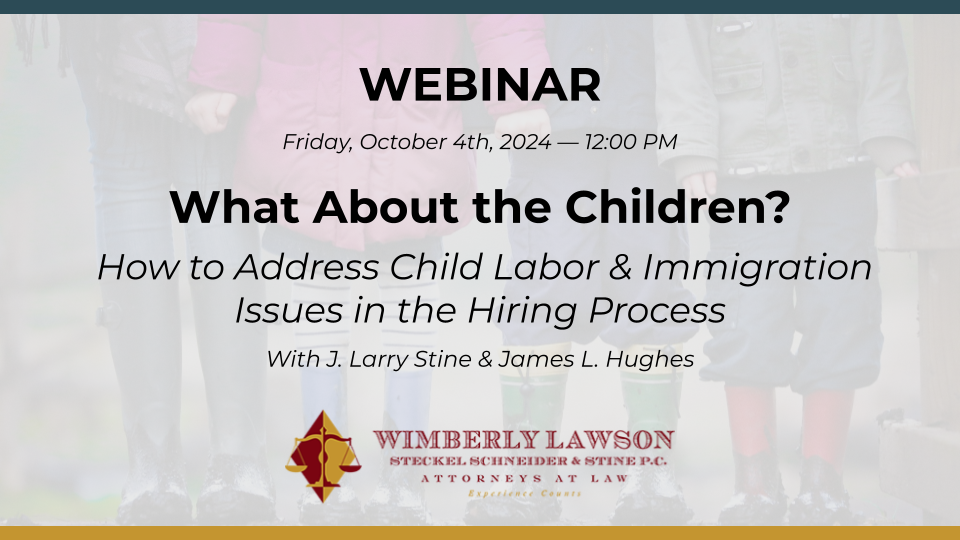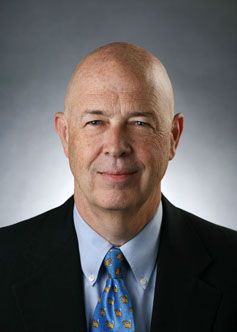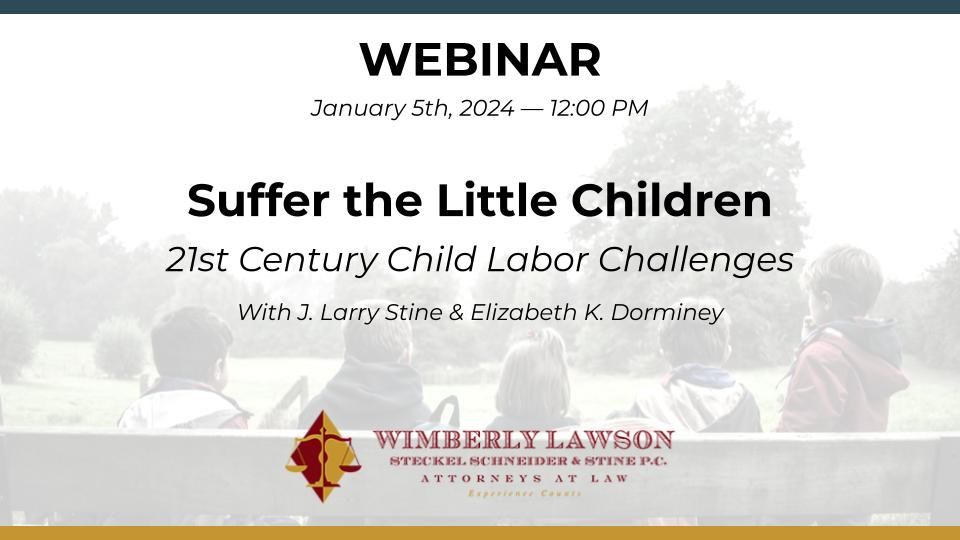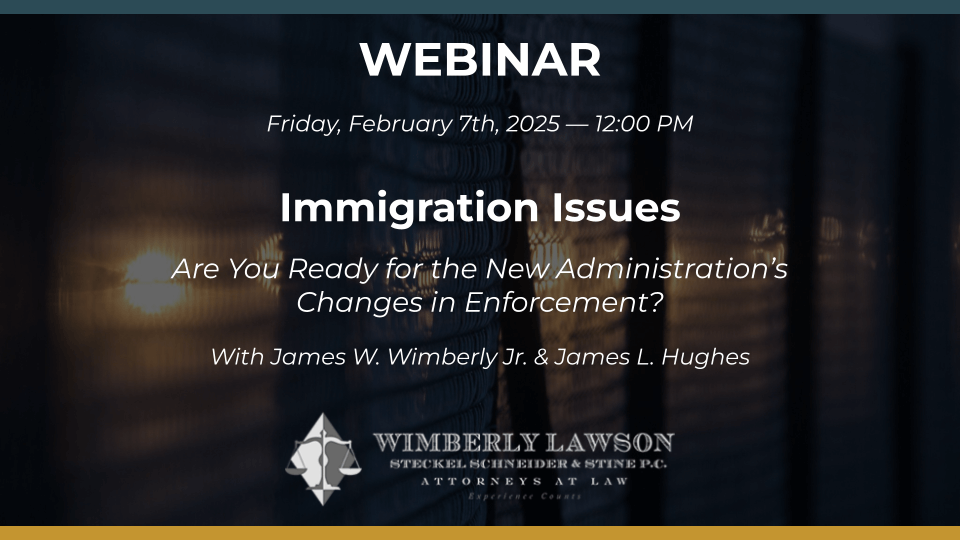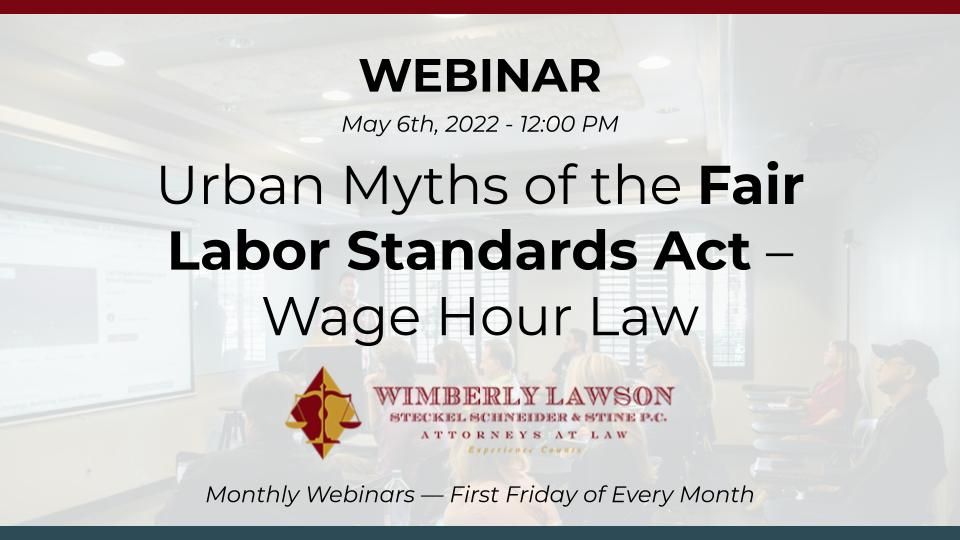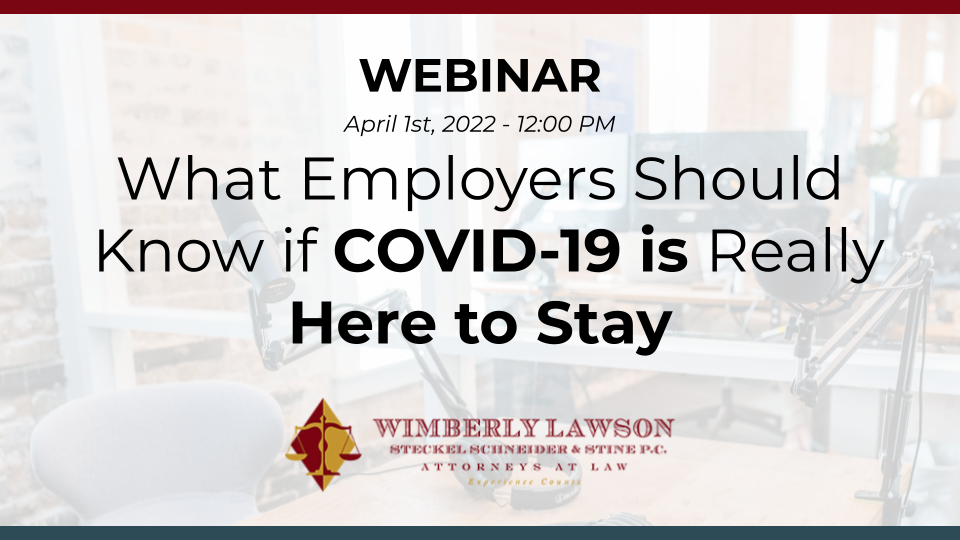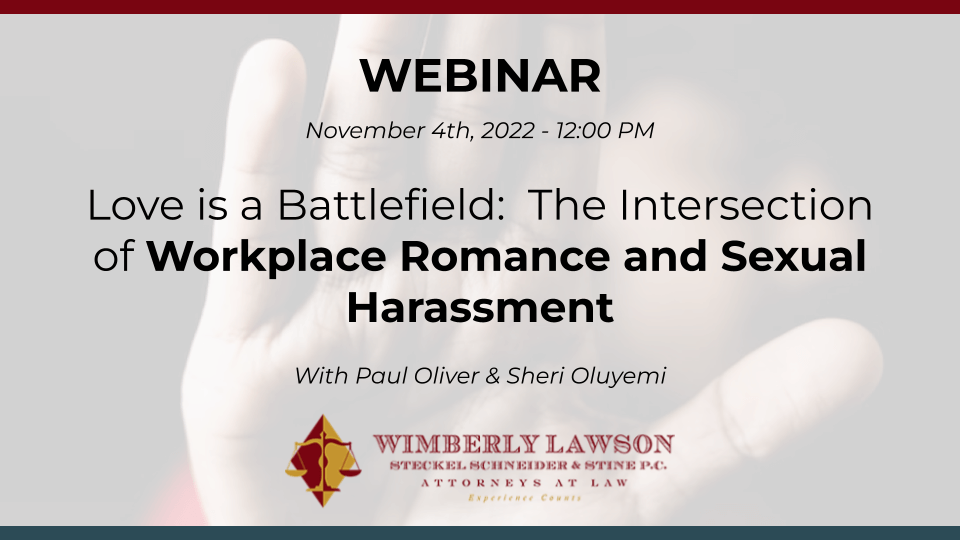
What About the Children? How to Address Child Labor and Immigration Issues in the Hiring Process
Dealing With Child Labor and Immigration Issues in the Hiring Process.
Historic levels of immigration, including countless unaccompanied minors; and a tight labor market have produced a “perfect storm” involving employers, recruiters, ICE, and the U.S. Department of Labor, and minors. In this seminar Senior Principal Larry Stine and Jim Hughes will review recent prosecutions that are making their way through the courts and offer practical advice on what jobs minors are allowed to perform, and how employers can comply with the child labor laws without running afoul of the limitations inherent in the I-9 and E-Verify.
Watch This Webinar
Webinar Transcript
James L. Hughes (00:00):
Ladies and gentlemen my name is Jim Hughes. I'm here today with Larry Stine, and we will talk today about child labor and immigration issues and the hiring process. Larry, why don't you start us off with a little bit of the history about the child labor law. So
J. Larry Stine (00:17):
The title is What About the Children? We wanna address child labor and immigration levels, and we, we want to talk a little bit about the history, because it's kind of important to put this into context of where it is. So, basically, as long as they've been work to do, the children have been working in the 19th century. They've work everywhere. It was very common to see children earning their paycheck in the United States. In fact, the first reformer really didn't start until the earliest 20th century. So the first federal law was passed in 1916 to buy, to ban child, child labor by Congress. And they banned the interstate selling goods produced by factories that employed children younger than 14, and by children who under 16, who worked more than 60 hours per week. However, that in that time, they were taking a narrow view of the commerce provisions. And so the Supreme Court struck down the 1916 law 'cause they said Congress lacked the power to regulate goods manufactured by children's. And that, that that decision was not overruled until 1941 in a case that upheld the, the Fair Labor Standards Act that included the child labor provisions. And they, at that point, redefined interstate conference.
J. Larry Stine (01:49):
And basically the laws that were passed in the Fair Labor Standards Act in 1938 are basically the same now.
James L. Hughes (01:58):
Well, Larry, why don't you tell us what those laws are in layman's language?
J. Larry Stine (02:03):
<Laugh>. All right, I'll try to do that in layman's language. Let me, let me tell you something. When you read these regulations, they are dense and tert and very complicated, but we'll try to simplify it to some degree. And for children under 14 years of age and non-agricultural employment, they just can't work this period. They're probably been, except in agricultural settings where you can work.
James L. Hughes (02:32):
So that's like working on a farm. If, yeah, if I had a farm and my 12-year-old daughter wanted to work, she could
J. Larry Stine (02:41):
Work, yep. At 12. And, and matter of fact, if it's your child, you can actually work 'em on the farm as the, AS 10,
James L. Hughes (02:47):
And I don't have to pay them
J. Larry Stine (02:49):
<Laugh>, you don't have to pay them. They're exempt in every way. But for the most of us 14 is really the magic agent. You just, you've got somebody's 13 and a non agricultural, it's just prohibited. So the next thing is, is that for children between 14 and 15, and typically what will happen is the name that Wage Hour uses is the Charlie Labor Reg three on why it's not number one or number two, but it's child labor. Reg three, and this is the one that basically says 14 and 15 year olds can work in certain occupations and with limited hours. So there's restrictions. They can work as be allowed of work as few as 18 in a week and during school work. So not very many of 'em will work that way. But then for the 16 and 17 year olds, there is basically 17 hazardous waters, and they can work anywhere except for where it is prohibited under a hazardous order.
James L. Hughes (03:59):
So given that these laws have been around for a long time, why is there such an issue today?
J. Larry Stine (04:06):
Well, a good question, Jim. The, the, the, the problem has been kind of escalated over the last number of years because we're having such a large number of migrant children come over from Mexico and they're, you know, they're coming from grinding poverty and gang violence, and I'll, I'm, I'm being very kind. They're relaxed. Border policies for unaccompanied minors facilitate their entry into the United States. They're supposed to be taken in the homes of sponsors. And some are, and those that do typically are family members, others don't. But the problem is they have other needs and they're coming. Their families are not exactly rich and don't exactly have a lot of ability to, to support them. So that's one of the aspects of it. And so you'll end up with this famous picture. This is a picture from that child wage hours using a lot because believe this is a 12-year-old working in a cleaning the poultry plant.
J. Larry Stine (05:20):
So their economic and social pressure, let's talk about those. So the sponsors charge these kids rent oftentimes, and then they, to get here in the first place, they have to go through coyotes to help them travel across the border and expect to be paid. And that could be several thousand dollars. And coyotes are not your local bank. You know, if you don't pay them, they're likely to take extreme actions. Like if you have relatives left behind, they might kill 'em. If they have relatives on this country, they may harm them. So there's they're very motivated, earn money so they can send it back to pay the coyotes and then help their families. And a lot of 'em then seek work wherever their relatives are, which just kind of makes sense. Now, most employers have policies of not employee anyone less than, than 18, particularly in an industrial setting.
J. Larry Stine (06:17):
It's just not the smart thing to bring in 16 year olds. You can, but you better be more aware of those hazard resorts before you do it. And some employers do use 'em. I mean, if you've ever been to some of these amusement parks, you know, like white water or Six Flags, you'll see 16 and 17 year olds working in those operations. But you, but those people were pretty aware of what their hazardous orders restrict. And there's a ready market for false papers out there so that, you know, highly motivated will people will commit fraud. Do these children come from countries where child labor is common? Yeah, they do. We, I, we've looked at it, for example, we've done some work in Mexican laws. They no more work than six hours a day for children under 16. Well, guess what that means?
J. Larry Stine (07:13):
By 17, you're working. And a lot of these children come from very poor families, and a lot of times their educational levels go to third grade. Then after third grade, they start trying to make them work. And they, this is one of those laws that's ignored by everybody. It's interesting, I was doing a child labor audit at one of our clients and I pulled a, an application when I checking 'em out from a young woman who was 18 years old, who was actually American born, born from Mexico, Paris. But they went back to Mexico, and I'm reading her application and she has two years of, of poultry experience in the Mexican plants. Before she came here, we were able to check her because she had American documents. So we were able to verify the, the American rules, which is a lot easier to do. She was 18, but she had two years of experience in mixed poultry plants.
J. Larry Stine (08:18):
And so, oops it's, it's been a perfect storm with the kids in, in, in the center. So there's a lot of things going on. So we got, some employees are hiring a large number of workers, and they're having to rely on labor providers to do that because in certain areas they're, they're, they're very strapped for workers. And so they've got them hiring lots of people. Some of these places hire 50 people a week, which a lot of employees would go, that's insane. But that is in fact what happens. And the other, one of the other aspects is that the, the miners are, are desperate for work because remember, they gotta pay rent, they gotta pay the coyotes, they gotta send money back home, and it's easy for them to get fraudulent paper. It is, it's, there's a whole industry out there. It is not hard.
J. Larry Stine (09:12):
And they know where they are. And on top of that, you know HHS Homeland Security severely limits the employee's ability to delve into those peppers, as you well know. And one of the other things is, a lot of times people that would probably be the most knowledgeable of this are the first line supervisors, but a lot of the first line supervisors in some of these places are Hispanics who have come from the same thing. And they know the problems they got. They know that they got ability, having problems being coyotes, and they don't wanna ride 'em out because if <laugh>, if they tell the upper management they're under 18 every employer I have will do the same exact thing. They will fire their very quickly because it's dangerous for them to have that. And so the family and the community pressures kind of help out to discourage reporting minors to authorities.
J. Larry Stine (10:15):
Well, Larry, you mentioned earlier something about hazardous orders. What are hazardous orders? Uhhuh, right? Well, there's a series of hazardous orders. I've told this one but they've issued 17. And when I've talked about it being turt and dense, believe me, they're turt and dense. I mean, in things that you wouldn't even know. For example, a dough mixer, okay? Wage hour takes the position that the size of the ring and the dough mixer makes a difference. Now it's not in the regs. You have to go very go beyond the regs to find out that they'll allow an A, b, or C ring, won't wanna allow a d-ring. And so it's, it's a very complicated area that very few people deal into. And HO 10 is a, a hazardous order that typically applies to poultry, beef, that sort of thing. So they are very complex.
J. Larry Stine (11:16):
And so there's, here are the, here are the 17 headings. So manufacturing or story and explosives. Well, you can see handling the explosives could be considered hazardous driving a motor vehicle and being an outside helper on a motor vehicle. This one is really weird because we allow 16 and 17 year olds to drive. They're driving, you know, about with unrestricted licenses, they drive for their family, they drive to school. And so it's very easy to see why employers would say, well, the heck they're driving anyway, I can use a 16 or 17-year-old to drive a motor vehicle. But guess what? For the most part, there are exceptions. You can't have a 16 or 17-year-old drive motor vehicles for you while they're at work. They're coal mining, logging, power driven woodworking machines, radio activity, hoisting. You can see them on the, the, the, the meat packing and processing.
J. Larry Stine (12:20):
Okay. It, it, so you think when you look at this, meat processes have meat packing that only applies to poultry, right? And or it's beef or the pork. It doesn't, that's the weird thing about some of these hazardous orders. It has power driven meat slicing machines. So when you go to some place like Arby where they're using those five things to slice the meat, or at the Publix's deli, that's a hazardous order. If somebody on Jersey, mikes Jersey, Mike's, yeah. If, if they use a 16 or 17-year-old to use that splicer, they're violating the child labor laws. And so it, it, it gets very complex and you've got to kinda look at this because there are things in there. You would think, oh, it doesn't apply to this operation, but it does. And you have to be kind of careful. So and that's where they are.
J. Larry Stine (13:11):
And so I wanna look a little bit at the HO 10 rules, because that seems to be where wager has really been putting their their effort in lately. And it's and, and 29 c ffr five 70.61 five 70, or the ones that lay out all the 17 hazardous bores. So the poultry, you can't use anybody under 18 in first processing. That's where they're basically killing eviscerating animals. And so you can't do that. Typically what happens in this is they define, this is when you chill the, the meat that ends the first process. And so after the chilling process, you're out of the first processing, not in the boning occupation. It's, it's clear what it is in beef packing facilities because they actually have physicians they call boning applications but not in poultry. The, the, the field operation handbook, the FOH seems to allow de-boning, but it is not wage hour's current position. They have basically just said de-boning is not there, but the FOH seems to say, so, so they're being a little contradiction, which they're doing a lot of.
James L. Hughes (14:26):
So if on the second processing line, someone is cutting a wing off the carcass of a chicken, right? Is that a boning occupation?
J. Larry Stine (14:38):
Well, that's the interesting thing from the di definition of a boning occupation. What it says is, if you are just cutting through bone, oddly enough, it's not a boning occupation. So to cut the wing off, and we had this as an issue in the case, and the judge found that that's not a boning occupation. The idea of buying boning occupation is to remove the bone from the meat, not to cut through the bone. So we get very fine definition. So if
James L. Hughes (15:07):
You're cutting the breast meat away from the bone to make chicken breast, is that boning?
J. Larry Stine (15:15):
Maybe don't, don't you don't you love my definitive answer. Maybe it's, it's arguable at that point because it, it, it, some ways it looks like the idea behind it is to pull the bones out, to use the bones, which they do and be comport and poultry, they don't do it. But because the definitions are so unclear about what that is, that it is, it is questionable at that point if they're just cutting the wings off or, you know, pulling something off just to pull it off, and they're not dealing with the bones, probably not if they're pulling bones out, that's a definitive, maybe <laugh>. Okay. So the, the other things about the O 10 that it doesn't include small gain but it, it then that was, they added that in 2010, believe it or not, from the beginning of this until 2010 poultry wasn't included in the, the beef. And the rest of the facilities ev not everything is prohibited now, however, so much is prohibited that it really is a good rule not to hire anyone under 18.
James L. Hughes (16:30):
Now, you touched on doll's enforcement positions. Why don't you go into a little bit more detail about that?
J. Larry Stine (16:37):
Okay. The, the, the solicitor labor has issued a but the, she called a enforcement report and they issued that for the fiscal year 2023. And they highlighted a couple of cases, and this is gonna give you kind of a good feel of what's going on. So the first case, and this is the one that made the news to start with, was the Packer Sanitation services. And he gets commonly known as PSSI. And in that case, the court issued a TRO and a consent judgment and joined the company from future violations and putting compliance measures in place. And they paid in February of 23, a historically large $1.5 million in civil money penalties for child labor violations for having 102 children in hazardous occupations, 13 facilities, <inaudible>, it's, it's interesting, I spoke to the PSSI lawyers. They were also taking the same position. We've been taking that, hey wager, if you tell somebody who's under 18, we're, we're, they're gone.
J. Larry Stine (17:51):
We, we don't care. We're just on fire. 'em. And when I was talking to them, they came through and they told them that this Guatemalan, and the reason I'm pointing out Guatemalans is because they, because of their nutrition stuff, they tend to be very slight and small people, and they look really gone. Well, they told fire somebody, it turned out this worker who was turned out to be 29 years old. He was at Guatemala, and, but he was born in America. So they were able to go back and verify it when they went back to the Department of Labor and says, you, you had fire a 29-year-old. Their response is, well, we were just trying to protect him. Well, they protected him by making the company fir him from a good paying job. So you, you know, sometimes you gotta look at something. So
James L. Hughes (18:34):
Appearance is not necessarily a determinative factor in whether someone's a child.
J. Larry Stine (18:39):
No, it's not. And the decision that we got from Marja, the judge pointed that out, that that is not something that you can just rely on because there are people who look much younger and basically you're discriminated against them because of their looks. And another case was this monogram meets snacks and they, they agree not to ship the goods while they discuss compliance with their <inaudible>, but this is something about hot goods we'll get to. And they went ahead and got a consent order and a judgment. And then one more was exclusive poultry. They got a preliminary barring them from shipping, but that was not a disputed one. And then they entered a consent judgment and they agreed to pay $3.5 million in back wages and damages to $200,000 in other violations.
James L. Hughes (19:32):
Now, when they agreed to pay three and a half million in back wages, who would the wages give to?
J. Larry Stine (19:40):
For the back wages? It would go to the employee. The penalties go to the Department of Labor and go into the treasury
James L. Hughes (19:47):
And, and which employees would get the back wages.
J. Larry Stine (19:51):
In this particular case they had an, it would, it was overtime and minimum wage issues in addition to child labor. So that's the reason they had the back wage aspects. There is no back wages for a child labor violation, and there is no money paid to the mine. So it all, all the money that is being collected for child labor goes to the United States Treasury ultimately.
James L. Hughes (20:18):
Now tell us about hot goods.
J. Larry Stine (20:21):
Well, hot goods is real interesting. It's been in the act almost from the passage. And then there's two hot goods provision. There's a hot goods provision for not paying minimum wage and overtime. And the Department of Labor has used that provision for years, for years to seize and stop shipment of goods from his payroll cases. So there's a lot of case law on that, but there was also a provision that said it was hot goods if the goods were produced by child labor. And so that can be a real problem. So for example, wage and I were threatened to impose a total embargo on a plant produced production in some recent child labor cases. And basically they take the position that it impacts the goods going 30 days forward. So for the 30 days going forward, you're not supposed to be doing any shipment.
J. Larry Stine (21:14):
Well, the, the problem is, if you're dealing with something that is perishable, that's an enormous penalty. And it also has a major impact to faculty or suppliers, and it has a major economic, now, it does allow them to get a court order to prevent it to go get a TRO. And it can not only apply to the people who are in the possession of goods or produce the goods, but if they have shipped them, they're hot and wherever they are that they can be stopped. So that's, that's the memorandum I really can't see. But that stopping the shipment of goods is only pursuant to a court order. Yeah, it is only pursuant to a an order. But part of the problem is wage. Java's been doing what I think is extra judicial activities by trying to notify the downstream purchasers that they believe it's hot goods.
J. Larry Stine (22:17):
Now, I will tell you, they did that to some farmer in blueberries and basically extorted a settlement out of them. And the blueberry farmers went back to that judge and said, that's coercive and extortion. Make us agree to this. And the judge in Oregon, federal judge in Oregon, agreed and let them withdraw their consent to the aspects. So there's some real problems with what they've done when they do it extra judicially or before. So the, the, the prohibition has never been really successfully enacted without the consent of the employer, no responses. So they did follow a motion for TRO in a preliminary injunction in federal court in Alabama that wasn't, was contested. And they had a two day hearing and which now lost the case. And well, the problem is, you know, when you do something like this and it was done to a poultry plant, it impacts the workers.
J. Larry Stine (23:18):
It means you lay off a thousand employees, your your suppliers, the people who are gathering them, who are raising them, the hatcheries, the fee. It just has this enormous economic impact upon it. And the judge acknowledged that, and that was part of the aspects of looking at it and weighing the equities. He also had some problems with other things we'll talk about anyway, and embargoes and perishable goods. Frankly, it'd be a, a business death sentence from an awful lot of businesses. You know, how can you handle that? That's reason the blueberry farmers collapsed under the pressure because the blueberries would be no good in 30 days and they had no choice. So we don't look at two cases, Mitchell versus Hearst. This was until 2023. This was the last reported case where U-S-D-O-L saw the Hot Goods injunction for child labor. And that was in the fifties.
J. Larry Stine (24:19):
So it had been like 70 years or since wage and Hour had tried to get an injunction. And the, they proved that the employer had violated the child labor provisions on two occasions, and they didn't even attest it. But the government's request for an injunction was denied because the court concluded there were no reasons to believe future violations would occur. And they inquired only to ascertain whether it was a abuse of process, the Court of Appeals, and they did not have it. So the next here is the first and tested case where wage hour went in and has filed A TRO in a preliminary injunction, which the employer contested the case. So this happened in 2024 and wage and I filed a motion for temporary restraining order and a preliminary injunction to stop the shipment. The poultry good for 30 days going forward. And a two day hearing was held along with briefs being submitted. And what happened is the court denied the motion and found that wage, and I did not even attempt to prove knowledge, and that's a portion of her prima facie element.
James L. Hughes (25:29):
Let's talk for a minute about knowledge. What does it mean plus knowledge significant?
J. Larry Stine (25:35):
Well, it's interesting because the first thing is fairly understanding object, which is the basis of the power of labor. And its definition for employee defines employment as suffer or permit. And so the sufferer or permit has this connotation of knowledge. And of course when we talk about knowledge and courts, they always have constructive knowledge. You either knew or you should have known, you should have taken appropriate actions. The interesting thing in this case is wage and I were took the position that if it was a violation, that they didn't have to prove knowledge at all and that that's a strict liability concept. And the court was compelled to follow controlling precedence from a fifth circuit case that controlled it. They said you had to prove knowledge or constructive knowledge to do so. So it's critical. And a lot of the compliance issues that, and the things that we're gonna suggest late to that aspect of it is how did you, how do you show the, that you don't have knowledge or don't have constructive knowledge?
James L. Hughes (26:39):
So there is a continuing conflict between whether you have strict liability for child labor violations versus only if you have knowledge
J. Larry Stine (26:50):
Correct. The child labor. Correct. And, and major still taking the position of that, despite having lost this TRO and honestly, I can't find a single case that actually says it's strict liability. What, what the cases they keep citing say there's strict accountability. And what they're saying with strict accountability is you got, you got Mr. Employer a burden to show that you engaged in your due diligence and you don't have constructive knowledge, but it does not a strict liability. They don't use the word strict liability in any case, the Department of Labor did. And so the, the, the court wage and I were also made an argument that the employer could not rely on E-Verify reports, and the judge denied that argument. They tried to argue at court and at trial that at the hearing that it didn't use dates, however, objected and judge sustained it because the person testified, didn't have any knowledge and they then testified that that was their belief.
James L. Hughes (27:55):
So what are the penalties if an employer either is in a strict liability situation or a knowledge situation?
J. Larry Stine (28:05):
Well, that's a good question. So basically up until 2023 at the end of it, it was pretty straightforward with it. And then wage and hour issued one of these memos field assistant bulletins they call them, and this is kind of the way that they, in the last since the start of the Obama administration has started to try to dictate things and policies and procedures by using field assistant bulletins. Not a very common use prior to 2008 matter of fact, I don't recall 'em ever using it, but they started using these things and so they, they, they tried to change those things. And so the, the, the previous policy was to assess child labor CMPs and non-serious injury and non-injury cases by it, by doing an initial CMP civil money penalty is what we're talking about for a particular type of violation, depending on the gravity of the violation. And they limited the assessment of hot goods on a per investigation basis rather than a shipment. And they did the record keeping the same way on a per investigation rather than a per employee basis.
James L. Hughes (29:26):
How is that different? What, explain what that means?
J. Larry Stine (29:29):
Well, basically for your example, when you come in and you had, didn't keep the right records and you've got 15 kids that are working by their claim in violation of a hazardous order they would assess you one fine of up to whatever the inflation amount is, which was 15,600. Recently. However, their position now is, oh, we get to multiply that 15,000 by 15. And as to the shipments, what they were saying is, you get the penalties if you ship goods, you got a $15,000 fine. They now were arguing and argued to us that they get to charge $15,000 for each shipment, which in the particular case ended up being multiple millions of dollars when you do $15,000 for each something chicken. But the problem is when you look at the statute and the language that Congress gave them, it doesn't seem to support this position.
James L. Hughes (30:33):
So you, you're saying that the per employee penalty and the per shipment penalty are not supported by the statute?
J. Larry Stine (30:44):
No, because the statute looks like it is. The way it's defined is by child labor violation, not per child. And it's actually a limitation on the penalty. So they're, they're violating, in my opinion, the, the the penalties limitations inside the statute. And, and, and basically the whole, the reason for the changes is they didn't like the way the fines were coming out. So they wanted to change 'em so that they could get a much larger font because, you know, it's kind of, they, they, they don't like the fact that they come in and they find 15 child labor violations of H of 10 and they get to do one H of 10 violation. So there's only 15,000 because you violated H of 10 in this period. They'd much rather do it for each child, but it doesn't not appear to be the right thing.
James L. Hughes (31:34):
So what are employers supposed to do given the new enforcement position of DOL?
J. Larry Stine (31:39):
Well, I, I'm guarantee nobody wants to be the subject of a wager investigation. Nobody wants to be get the bad publicity. 'cause You know that that hurts. So there, there's a couple, there's some things that we can suggest you do. So visual observations of employees. Now, that's what wage hour says. But that's, you just can't limit yourself. You can't do that. And because like I said, some of these young looking applicants are, are, are not minors. They're they're much younger because when you look at their nutrition needs and some of 'em have Indian backgrounds, so they don't have beards, you'll have a 25-year-old guy from Guatemalan that is five foot tall and 105 pounds.
J. Larry Stine (32:34):
You, you see somebody five foot pound and 105 pounds, you're gonna think they're a minor, a 25-year-old. So you just can't rely on it. But you can use that as kind of a, a beginning point. So one of the things that we've recommended for the HR staff is during the interviews ask for their birth date because you know, they're using false documents. They might have a birthdate of the person that they copied the the documents from and won't be the same as theirs. So if they can't remember their own birthdate, that's a good indication that something's going on, or if the birthdate doesn't match the documents they're giving you. Correct. Yeah, that, so you got the document and their documents as they were born on Christmas day and you ask them when they were born and they tell you they were born in May, you've got a right to go do a little bit more digging.
J. Larry Stine (33:27):
The next thing after when they, after you kind of get 'em in this place is, believe it or not, a lot of times if you got 'em at that point, ask them their age because they're already beginning to see what's going on. So some of the things that you can do in the interviews is when you're looking at somebody that's looks very young and you, you need to look, do a little bit more due diligence, ask a few more questions related to their age. And so that's kind of the things you can do. Now the other thing is, and I talked about this, is you can do some child labor training because it's the first line supervisors who see the problems, but they don't appreciate the impact to, to the company. And see, see the part of the problem is they don't know the impact of their inaction.
J. Larry Stine (34:16):
They're, they see a kid out there and they know the kid needs to be paying off the coyote, so they don't want to report it because they know what's gonna happen. Well, that's fine, except they don't understand the impact of their own company. And so a lot of the training needs to be there so that the first line supervisors know you don't do this, they might come in and shut us down or try to shut us down. And it has a major impact on us and bad publicity. And believe me, the bad publicity has, can seriously impact your customer base. Even if you win, it can right seriously impact your base. So other, the other things is for labor providers, one of the things that we found in one of the child labor investigations I did is what looked like happened is an older person went to labor provider, got the job, got a piece of paper, just a piece of paper saying, Hey, this is so and so, he, you know, he's cleared I nine and he's, he's coming over to work for you.
J. Larry Stine (35:19):
And they bring the picture in, hand it to them. And because of the labor providers doing the I nines and he verifies and payroll works, they take their picture and put 'em to work. Well, one of the things that <laugh> we have suggested since if you're using a labor provider, take a picture of the person you're sending so that when the company has the people coming in from the labor provider, they look at a picture and go, this is not the same person. At least in a few of those cases that we saw that that would've, that would've helped us. And having that, that would've kept us from Howard hiring that person if we had known those things. So you, you, you also needed for the labor providers to assure you that they're following the protocol to keep miners out. So what we have done in, in our contracts is put a provision in with the labor providers that they will do these things.
J. Larry Stine (36:14):
And we also, and I didn't put it in here, but if you're in a high profile area, one of the things I think you want to do is perhaps bring in a wager investigator, former wager investigator and have them do some audits because it gives you an extra level if they come, if you clear that investigation and obviously you find something, you let them go and then, then you're clear it will help you a lot. And if you got school districts, you can call the school districts and they'll give you some information. One of the things that wage already did was go to school
James L. Hughes (36:45):
Districts. Yeah. But sometimes children will give the real names to the school districts on fake name to the employer. So how's an employer going to check that?
J. Larry Stine (36:56):
Well, if you check it, you just get back. They're not, we don't have any children by that age. But now I've got another step in my due diligence. I did reach out to the schools, I did have Jose Cruz apply. I called him and said, do you have a Jose Cruz? But you know, blah blah, blah. And no, we don't. I've got another piece of defense that assures that I'm in compliant and, and I've got the issues.
James L. Hughes (37:24):
Well, given that schools are subject to privacy laws, let's say you hire someone named Jose Cruz, the school has someone named Jose Cruz, but they can't share information <laugh> with you about the the child.
J. Larry Stine (37:40):
Yeah, well, once again, they, if they don't help you out, they don't help you out. But once again, you can say, I reached out to the schools and they told me they wouldn't tell me that. So we, we've got all those issues. But the other problem we're we, we keep running into sometimes with the Ric Wall is the immigration side of the aspects. And, and why don't you tell us a little bit about that part of it, Jim?
James L. Hughes (38:02):
Well, certainly employers are now familiar with four i nine and the verify process and everyone knows that one of the first questions in section one of Form I nine is date of birth. Okay. And that date of birth should match the documents that the employee gives you. And if you're asking the questions, the date of birth and the age of the applicant should all match,
J. Larry Stine (38:35):
What happens? If they don't,
James L. Hughes (38:38):
Then you get to investigate further and you probably have someone who is either underage or is providing false documentation. Okay? And in either situation you have a basis for terminating or discontinuing the employment process, the hiring process.
J. Larry Stine (38:58):
Okay?
James L. Hughes (38:59):
Now as you also know you have to enter the information from form I nine into E Verify. And one of the questions is date of birth. So it is very important to make sure that the documents, the I nine Andy Verify all have the same date of birth and the employee gives you information that confirms their age and their date of birth. But,
J. Larry Stine (39:30):
But Jim, when, when I'm dealing with Wage and Hour or they were submitting stuff saying that that really doesn't verify the date of birth.
James L. Hughes (39:40):
Well actually E-Verify is a system that verifies the identity and work authorization based on the information provided to it. Right? So if an employee or applicant gives you information and that information is confirmed by E Verify, the employer does not have knowledge. If you're in a situation where you can claim you don't have knowledge, right. That the person is underage. And so it, it's very important that date of birth information is very important in the context of child labor issues. Also in that Marjac Alabama case, the judge found the fact that the employer had followed E Verify and I nine procedures to be helpful in indicating that the employer did not have knowledge, right. Of the child labor violations. It,
J. Larry Stine (40:44):
It's, it's a little unusual for the government to be arguing that reliance on a government system is not proper, but that's what Wage Hour has been
James L. Hughes (40:54):
Doing. Yeah. And Wage Hour, as you know, has their own system of age verification, which nobody uses <laugh>.
J. Larry Stine (41:02):
You, you know, I I I've been dealing with a wage hour law since 1975 and nobody's ever used that system for 50 years. It's been in, it is been in the rules, it's just unworkable.
James L. Hughes (41:13):
Yeah. It's a very cumbersome system and e verifies much more efficient and it gives the employer the opportunity to argue no knowledge because
J. Larry Stine (41:26):
Government told approach than it was,
James L. Hughes (41:28):
Right? Yeah. And you also know that the I nine Rules and the Immigration Discrimination Rules provi prohibit an employer from conducting a an absolutely thorough investigation. Right. You pretty much have to accept the documents as they are if they appear to be valid and appear to relate to the person who presents them.
J. Larry Stine (41:54):
So, so what happens if you go too far?
James L. Hughes (41:56):
Well, department of Justice may come knocking on your door and say you're discriminating and they wanna impose a lot of fines and harass you until you comply. So,
J. Larry Stine (42:09):
So the government basically does what the government normally does. It has you coming and going. That's right. And so if you do too much, they'll sue you. And if they do too little, they will sue you.
James L. Hughes (42:21):
Well, Larry it might be appropriate for you to give some closing comments and then after that we may be able to take some questions. Sure.
J. Larry Stine (42:29):
We'd be glad to. So here, here's, here's the conclusions. First thing is wage and I, our department's been making child labor a top priority and using these extreme penalties based upon that to drive the point home. I do know for a fact that they've been putting together Task force. The reason is because I've been this helping employers who are the subject or the target of these task force. And some of 'em I've been involved peripherally. I know there's a massive investigation going up on the Del Marvo peninsula because we represented a, a labor provider and got massive subpoenas from them and we've been subject of helping out some of our clients who've been the target. So it is, it is, it's because the child labor's out here that, and somebody minors are coming in here and basically in some ways it almost appears to us that they're trying to kind of move the focus of what the government's doing for letting the miners come across them to blaming the employers of being these mean nasty people who are trying to do it, despite the fact that every company that I'm aware of desperately doesn't wanna do it because they don't want to be subject to the Target.
J. Larry Stine (43:46):
'Cause If nothing else, the publicity is very damaging. Even if you win your case, the Hot Goods remedies was not even, it was finally upheld for the first time in 2023 because company did not oppose it. It was a default entry. But it is plain that the wage honor department's going to be trying to use it and they've come up with a new deviation on it. They will let you out of the Hot goods if you give them all your profits for 30 days. And so they're trying to do that. They have not had that taken the decision yet. We have some serious questions as to whether they have the authority to do it under their statute. And then basically I would say take a second look at your applicants, your employees, if you haven't engaged in some of these detailed information looking at the child labor aspect of, in a much more intense way without him getting in trouble with immigration, which was a fun thing to do, you need to do that just because you don't want to be subject to one of these things. So those, those are some of the things y'all can do and some of the concerns. I'm gonna stop sharing now. And we've got a few minutes. We've talked for 45 minutes straight. And we want to give you the chance to ask any questions If you'll put 'em in, you know, chat. We would be glad to answer any questions. So you
James L. Hughes (45:21):
Wanna bring up chat so we can see it? Yep.
J. Larry Stine (45:24):
There's chat. So we've got chat set up, so if you'll just type in chat, if you've got any questions, we'll be glad to help it. I will tell you the child Labor decision and Mar Judge preliminary, that litigation's ongoing and there probably will be a decision sometime in 2025 for the final decision on that particular issue. Particular issue. They've also have sued a Hyundai and Alabama auto manufacturer for a single child labor and they're also trying to get them to divest an entire months of net profit under the Hot Goods. And they've been the, the Department of Labor and Wage and I being extremely aggressive. I've very seldom seen them this aggressive in some of these cases that they've been in that one. But for right now, it is the number one priority of wage. And I, and my suspicion is it will be the number one priority of wager through 2025. Because it's, it's something that's gotten a lot of people agitated and there's a lot of bad publicity and Wager is getting good publicity 'cause they're going after 'em. So that's one of the things that you can count on is something occurring for the next year or so is Wage an Hour if they show up, they will be looking at your child labor even if they come for any other reason.
James L. Hughes (46:51):
Now you were interviewed on some big network Yeah. Child Labor
J. Larry Stine (46:56):
Once. Yeah. Who was that? I was, I was interviewed by NBC News and they in a mini documentary, which has a wonderful title slaughterhouse Children. Mm-Hmm. <affirmative>. So if anybody is interested in seeing my whole minute of Interview and Slaughterhouse Children, is it
James L. Hughes (47:16):
On YouTube now?
J. Larry Stine (47:17):
I don't know if it's on in YouTube. I looked at it on NBC News and it's still still there. I wouldn't be surprised it's gone out there. But we've made some defenses about it and, and honestly we think we have the better position. I think the employers are trying their best to comply with these things and with a, as well as they can within the restrictions to the immigrations.
James L. Hughes (47:42):
So we wanna thank you for participating and if you do have any questions after we leave this webinar, please feel free to contact Larry or me at Wimberley
J. Larry Stine (47:54):
And Lawson. Yep. And we'd be glad to answer any questions and we'll post the the slideshow and we'll post the webinar on our website later so you can see that. 'cause We record them and all the webinars are posted. So whenever you wanna look at one, you can go talk and go pull up whatever topic interests you. And there's, I don't know, dozen 20 on there now. So thanks for watching. We appreciate your time and we will end the webinar at this time. Thanks.
